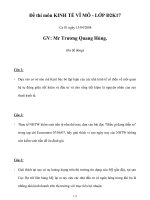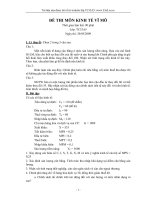Đề thi: môn kinh tế vi mô: hướng dẫn sâu về mối quan hệ cung và cầu cho sinh viên ngành kinh tế
Bạn đang xem bản rút gọn của tài liệu. Xem và tải ngay bản đầy đủ của tài liệu tại đây (7.6 MB, 186 trang )
CHAPTER 2
DEMAND AND SUPPLY
© 2011 Pearson Education
2
Demand and Supply
CHAPTER CHECKLIST
When you have completed your
study of this chapter, you will be able to
1 Distinguish between quantity demanded and demand,
and explain what determines demand.
2 Distinguish between quantity supplied and supply, and
explain what determines supply.
3 Explain how demand and supply determine price and
quantity in a market, and explain the effects of changes in
demand and supply.
© 2011 Pearson Education
2
CHAPTER CHECKLIST
When you have completed your
study of this chapter, you will be able to
4 Explain how a price ceiling works and show how a rent
ceiling creates a housing shortage, inefficiency, and
unfairness.
5 Explain how a price floor works and show how the minimum
wage creates unemployment, inefficiency, and unfairness.
6 Explain how taxes change prices and quantities, are shared
by buyers and sellers, and create inefficiency.
© 2011 Pearson Education
2
CHAPTER CHECKLIST
When you have completed your
study of this chapter, you will be able to
7 Define, explain the factors that influence, and calculate
the price elasticity of demand.
8
Define, explain the factors that influence, and calculate
the price elasticity of supply.
9 Define and explain the factors that influence the cross
elasticity of demand and the income elasticity of demand.
© 2011 Pearson Education
COMPETITIVE MARKETS
A market is any arrangement that bring buyers and sellers
together.
A market might be a physical place or a group of buyers
and sellers spread around the world who never meet.
COMPETITIVE MARKETS
In this chapter, we study a competitive market that has so
many buyers and so many sellers that no individual buyer
or seller can influence the price.
2.1.1 DEMAND
Quantity demanded is the amount of a good, service,
or resource that people are willing and able to buy
during a specified period at a specified price.
The quantity demanded is an amount per unit of time.
For example, the amount per day or per month.
2.1.1 DEMAND
! Law of Demand
Other things remaining the same,
• If the price of the good rises, the quantity
demanded of that good decreases.
• If the price of the good falls, the quantity
demanded of that good increases.
2.1.1 DEMAND
! Demand Schedule and Demand Curve
Demand is the relationship between the quantity
demanded and the price of a good when all other
influences on buying plans remain the same.
Demand is a list of quantities at different prices and is
illustrated by the demand curve.
2.1.1 DEMAND
Demand schedule is a list of the quantities
demanded at each different price when all the other
influences on buying plans remain the same.
Demand curve is a graph of the relationship between
the quantity demanded of a good and its price when all
other influences on buying plans remain the same.
2.1.1 DEMAND
2.1.1 DEMAND
! Individual Demand and Market Demand
Market demand is the sum of the demands of all the
buyers in a market.
The market demand curve is the horizontal sum of the
demand curves of all buyers in the market.
2.1.1 DEMAND
2.1.1 DEMAND
! Changes in Demand
Change in demand is a change in the quantity that
people plan to buy when any influence other than the
price of the good changes.
A change in demand means that there is a new
demand schedule and a new demand curve.
2.1.1 DEMAND
Figure 4.3 shows
changes in demand.
1. When demand
decreases, the demand
curve shifts leftward
from D0 to D1.
2. When demand
increases, the demand
curve shifts rightward
from D0 to D2.
2.1.1 DEMAND
The main influences on buying plans that change
demand are
• Prices of related goods
• Expected future prices
• Income
• Expected future income and credit
• Number of buyers
• Preferences
2.1.1 DEMAND
Prices of Related Goods
A substitute is a good that can be consumed in
place of another good.
For example, apples and oranges are substitutes.
The demand for a good increases, if the price of one
of its substitutes rises.
The demand for a good decreases, if the price of
one of its substitutes falls.
2.1.1 DEMAND
2.1.1 DEMAND
A complement is a good that is consumed with
another good.
For example, ice cream and fudge sauce are
complements.
The demand for a good increases, if the price of
one of its complements falls.
The demand for a good decreases, if the price of
one of its complements rises.
2.1.1 DEMAND
2.1.1 DEMAND
Expected Future Prices
A rise in the expected future price of a good increases
the current demand for that good.
A fall in the expected future price of a good decreases
current demand for that good.
2.1.1 DEMAND









